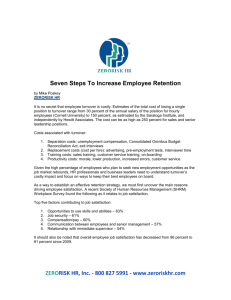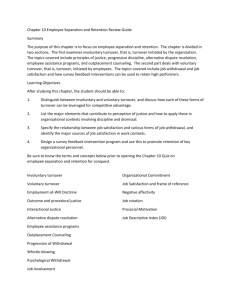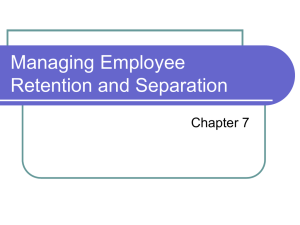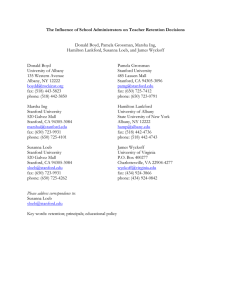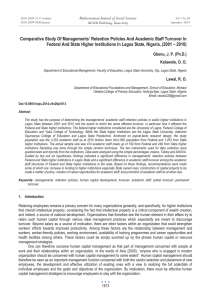Chapter 8 Employee Training and Development
advertisement
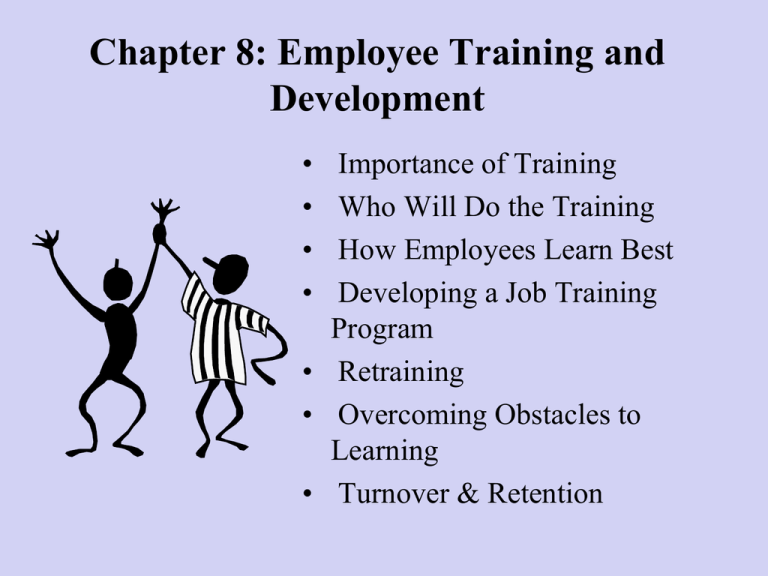
Chapter 8: Employee Training and Development • • • • Importance of Training Who Will Do the Training How Employees Learn Best Developing a Job Training Program • Retraining • Overcoming Obstacles to Learning • Turnover & Retention Importance of Training: Teaching People How to do Their Jobs • There are 3 kinds of training: – Job Instruction – Retraining – Orientation • The big sister, big brother, or buddy system is when a old hand shows a newcomer the ropes. • When good training is absent there is likely to be an atmosphere of tension, crisis, & conflict because nobody knows what to do. The Benefits of Training • Gives the supervisor more time to lead, standardizes performance, less absenteeism, less turnover, reduced tension, consistency, lower costs, more customers, better service. • Gives the workers confidence & knowledge to do their jobs, reduces tension, boost morale & job satisfaction, reduces injuries & accidents, gives them a chance to advance. • Gives the business a good image & more profit. Then why is training often neglected? • • • • • • • • Urgency of need. Training time. Costs. Employee turnover. Short-term associates. Diversity of worker. Kinds of jobs (simple-complex). Not knowing exactly what you want your people to do & how. Who will do the training? • The magic apron method: people train themselves the easiest ways to get the job done, & what will keep them from getting into trouble. • The person that is leaving trains: teaches shortcuts & ways of breaking the rules. • Big sister, big brother, or buddy method: passes on bad habits & may resent new person as a competitor. • The logical person to train new workers is YOURSEF! How employees learn best: • Learning is the acquisition of skills, knowledge, or attitudes. • The adult learning theory is a field of research that examines how adults learn. – A number of the following tips come from the adult leaning theory. How employees learn the best: • When they are actively involved in the learning process (to do this you must choose the appropriate teaching method). • Training is relevant & practical. • Training material is organized & presented in chunks. • Training is in an informal, quiet, & comfortable setting. • When they have a good trainer. • When they receive feedback on performance. • When they are rewarded. Developing a Unit Training Program • Training plans each represent a learnable, teachable segment of the job: – 1st Establish performance standards: they provide a ready made structure for a training program. – 2nd Write a training objective derived form above. – 3rd Develop standard procedures (list tasks & spell them out). Developing a Unit Training Program • This is taught in several sessions. • It should provide checkpoints to measure progress. • The method of training should include 2 elements: – Showing & telling the trainee what to do. – Having the trainee do it (right). • This is known as job instruction training. • The closer the training method, setup & materials are to the onthe-job situation, the better the training. • The location of the training should be a quiet place free of interruptions. • One-on-one training generally works best. – However, group presentations have certain advantages (general information). Developing a Unit Training Program • Your training materials should include the same equipment & supplies that will be used on the job, & they should all be on hand & ready before the training starts. • Developing a written training plan helps you to think out all the aspects of the training & to orient everything to the new employee & the details of the job. Moving from Plan to Action • Training people with some experience begins with a pretest. • Experienced associates should end up meeting the same standards as people whom you train from scratch. • Once the training process is complete EVALUATE. Evaluation • Formal evaluation: uses observation, interviews, & surveys to monitor training while its going on. • Summative evaluation: measures results when training is complete in five ways: 1. Reaction 2. Knowledge 3. Behavior 4. Attitudes 5. Productivity Job Instruction Training (JIT) • Also called on the job training. • Consists of 4 steps: 1. Prepare the associate. 2. Demonstrate the task. 3. Have the associate do the task. 4. Follow through. Retraining • Needed when changes are made that affect the job, employees performance drops below par, when the worker has not mastered a particular technique, or your people themselves may ask for it. • A positive one-on-one approach to retraining is referred to a coaching. • Coaching is a 2 part process: – 1. Observation of the employees performance. – 2. Conversation between manager & employee focusing on job performance. Overcoming Obstacles to Learning • Reduce fear with a positive approach (convey confidence in the worker). • Increase motivation: – Emphasize whatever is of value to the learner, make the program form a series of small successes, build in incentives & rewards. • Adjust teaching to learners level. • Laziness, indifference, resistance may mean a problem worker. • Approach training from the learner’s point of view. • Keep it simple, concrete, practical, & real. Overcoming Obstacles to Learning • Sometimes the training program is the problem. – If it is abstract, academic, impersonal, or unrealistic, it will not get across. • Sometimes the instructor causes the learning problems. – Trainers need to know the job well enough to teach it. – They need to be good communicators, able to use words other people will understand, sensitive enough to see when they are not getting through. Turnover & Retention • Many hospitality operations have a labor turnover of more than 100%. • Retention is the term given to keeping employees from “jumping ship”. Turnover & Retention • In study by the Hay Group over a ½ million employees in 300 companies were asked about important retention factors, the top 10 were: – – – – – – – – – – Career Growth, learning & development. Exciting & challenging work. Meaningful work. Great people to work with. Being part of a team. Having a good boss. Recognition of work well done. Autonomy & a sense of control over work. Flexible work hours. Fair pay & benefits. Turnover & Retention • Strategies for improving retention: – – – – – Hold 50/50 meetings. Practice management by wandering around. Work side by side with employees. Conduct exit interviews. Use other methods to listen (i.e. suggestion systems). – Recognize a job well done. © 2010 John Wiley & Sons, Inc.
